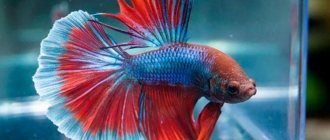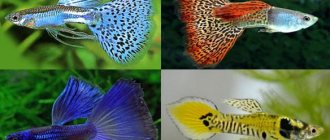Guppies are a viviparous species of fish with bright colors and large fins. The average length of males is 2.5-4 cm, while females are capable of reaching sizes of 7 cm. Having studied how much a guppy fish costs, the following figures were obtained:
- Average cost of guppy fish: 60 rubles per piece;
- Fry: 40 rub ;
- Rare breeds: 80-95 rub .
A detailed consideration of the issue will require focusing on factors such as:
- Types and colors;
- Points of sale.
Habitat in nature
The homeland of the guppy fish is the islands of Trinidad and Tobago, and in South America - in Venezuela, Guiana and Brazil. As a rule, they live in clean, running water, but also like brackish coastal waters, but not salty sea waters. They feed on worms, larvae, bloodworms and various small insects. Because of this feature, they even began to be massively populated in areas where there are a lot of malaria mosquitoes, since guppies eat its larvae. Male guppies in nature are much brighter than females, but their coloring is still far from the aquarium breeding forms. She must protect them from predators, since the fish is small and defenseless.
The aquarium fish guppies got their name from the name of the discoverer (Robert John Lechmere Guppy). Robert Guppy was the first to find and describe this fish on the island of Trinidad in 1866.
Description
A small fish, with males smaller than females, and usually reaching a length of about 5 cm. A guppy lives for 2-3 years, since its small size and warm water speed up metabolism and shorten its lifespan. As for appearance, it is almost impossible to describe. Guppies cross so often and so much that even dozens of selective forms can be counted, and even more common ones. Males and females are strikingly different from each other, but we will talk about this difference later.
Keeping guppies in an aquarium
Like all tropical fish, guppies love warm water (22-25 °C), but can live in a wider range of 19.0 - 29.0 °C. As for water parameters, for ordinary forms this practically does not matter. They adapt to local conditions so quickly that moving to a new aquarium is tolerated without any problems at all. It would be ideal if the aquarium has: 7.0 – 8.5, and hardness 12.0 – 18.0, but the parameters can be completely different, which will not prevent the guppies from living and reproducing.
The aquarium can be small; 20 liters is enough for 5 fish. But, the larger the volume, the more fish you can contain and the more beautiful it will look. It is best to have a lot of plants in the aquarium, as this will resemble the natural habitat and will significantly increase the survival rate of the fry in the general aquarium. Lighting can be anything from bright to dim.
It is advisable to use a filter; for guppies, an internal one is quite enough, but if there is an external one, then great. It’s just better to cover the holes in it with an additional fine mesh, since a powerful filter is not only capable of sucking in fry, but even adult fish.
Guppies cannot be called a schooling fish, but keeping them in pairs makes little sense. It is very small in size and in small quantities is almost invisible in the aquarium. For guppies, the rule is simple - the more there are in the aquarium, the more impressive and beautiful they look.
Guppy fish
Guppies have always been considered the most unpretentious aquarium fish in our country and therefore enjoyed enormous popularity. And this popularity is absolutely deserved, just look at the huge variety of color variations and shapes!
Natural populations of guppies are widespread in fresh and brackish waters of Venezuela, Guiana, north of the Amazon, in northern Brazil, on the islands of Barbados and Trinidad.
|
Even in our country, with its harsh climate, the population of wild guppies lives in the Moscow River, in places where warm waters drain.
Keeping guppies is not difficult.
|
Guppies adapt well to hard water and tolerate salinity well. They prefer fresh, clean water with regular changes and little current. When they are kept in old water with rare changes, the luxurious tail fins begin to cut and tear, and the fish fall into a depressed state.
Guppies also prefer aquariums with thickets of live plants. They do not live very long in aquariums - 3-3.5 years, at high temperatures even less due to increased metabolism.
Although guppies are unpretentious, they look most vibrant and impressive when the most favorable and comfortable living conditions are provided for them. To demonstrate bright colors, it is recommended to use bright lighting with rays of a certain spectrum.
when it comes to feeding . For them, it is necessary to select balanced food of animal origin with the obligatory inclusion of plant components; it is recommended to include frozen live food in the diet (so as not to introduce infections and parasites).
These foods rich in protein components include:
|
It is recommended to feed the fish 1-2 times a day in small portions. Like almost all other types of aquarium fish, it is recommended for guppies to leave one day a week as a fasting day, i.e. don't feed at all.
Although guppies are hardy creatures, they are susceptible to the same diseases as other tropical fish. Most often they get sick:
|
The basic rule to remember: it is better to prevent a disease in advance than to treat it. That is why, first of all, you need to provide the fish with everything they need, and try to bring the artificial conditions of the aquarium as close as possible to their natural habitat. It is also important to remember that before being planted in your aquarium, all fish must undergo quarantine in a fish tank.
Guppy - reproduction and breeding
Breeding guppy fish is extremely simple; they reproduce independently in a community aquarium without any additional conditions. In this case, there may not be a male for a long time, since females can bear offspring many times after one fertilization. You can buy one adult female at a pet store and she will produce offspring for you up to 8 times. As everyone knows, guppies are viviparous. Instead of caviar, they spawn fully formed fry that are swimming and ready to feed immediately. The eggs develop inside the mother, and she lays the fry already fully formed, like miniature copies of their parents. Fertilization occurs in the mother's body with the help of a special organ of the male - the gonopodium, which is formed from the anal fin.
“Pregnancy” of females lasts 35–45 days, depending on the water temperature. The number of fry in females varies. It depends on her age, size and feeding. For the first time, females spawn about a dozen fry, and the old ones spawn up to a hundred.
These fish are “bad” parents; they will readily eat their own young if they are hungry. Therefore, if you are planning to produce offspring, the female must be placed in a separate special vessel with a large number of small-leaved plants before giving birth.
A few days before giving birth, the female’s abdomen increases greatly and takes on a square shape. As soon as the fry are swept out, it must be removed. In a well-balanced aquarium, many guppy fry will survive unattended, hidden in dense vegetation, and once they grow up, they will be safe, but due to the lack of food in the general aquarium, the fish will have small fins and dull colors.
- What kind of snakes are kept at home?
- Ancient dog breeds
- Dog's sense of smell
- Maine Coon
- Domestic iguana
- How much does a raccoon cost?
When large adult males with large fins and tails are used for breeding, problems with fertilization may occur due to their slow movements. In this case, it is better to use young males, who are more nimble, or place the desired pair in a separate small aquarium. In a community aquarium, young males always have an advantage when mating.
To feed guppy fry, you can use any food of suitable size. Considering that the fry are born large, there are no problems. To obtain high-quality specimens, the food must be varied, and the nursery aquarium must be kept clean and some of the water must be changed periodically.
There is one difficulty in breeding these beautiful fish. As soon as the sex of the juveniles begins to be determined, the males must be transferred to another aquarium. It is necessary to track the developing males very carefully, since even one that is not accidentally noticed will be able to fertilize all the females. And with random crossing, it will not be possible to maintain the color line and shape of the fins. For reproduction, the best pair or several fish, in terms of body shape and color, are selected and kept constantly in a small aquarium. As you can see, to breed purebred guppies, you need to have several aquariums.
There is one more feature when raising guppy fry. Young fish grow for quite a long time, but a young male, having reached sexual maturity and colored, practically stops growing. The higher the water temperature, the faster the males mature. At 30°C this takes three months, then the male almost stops growing and remains small. At 22°C, males mature much longer, but manage to grow larger.
Recently, messages about the aggressiveness of fish that were always considered peaceful have often appeared on forums. They write the same about guppies. It is clear that such small fish will not risk attacking their larger neighbors, but among themselves, in a flock, relations can become tense. In this case, it is worth paying attention to the conditions of their existence. Aggression can increase sharply with a high density of fish in the aquarium, low water quality and a large amount of organic compounds in it, and diseases that cause pain in fish. Lack of oxygen and harmful chemicals in the water can provoke aggression. Therefore, the first thing to do in this case is to improve the living conditions of your pets.
Types of guppies
Let's look at the main standards for fin shapes recognized by breeders:
1. Fan-tail – the shape of the caudal fin is a sector of a circle (an open fan). The length of the caudal fin ranges from 8/10 to 5/10 of the body length. The angles at the base are from 90, not less than 75. The rear end of the caudal fin is rounded and convex. The upper and lower edges of the caudal fin are either rounded or straight;
2. Acute-angled fantails - the shape of the caudal fin is an elongated horizontally isosceles triangle. The length of the caudal fin ranges from 8/10 to 5/10 of the body length. The angles at the base range from 30 to 55. The posterior end of the caudal fin has straight edges. The dorsal fin is narrow with a pointed end;
3. Edged fantails - the shape of the tail fin is an isosceles triangle. The length of the caudal fin is from 8/10 to 5/10 of the body length. The angles at the base are from 70, not less than 50. The rear end of the caudal fin has straight edges. The dorsal fin expands from the base and has a blunt end;
4. Top sword – the shape of the tail fin is an oval. The length of the caudal fin ranges from 6/10 to 9/10 of the body length. The angles at the base of the caudal fin between the upper and lower rays of the “swords” and the axis of the body form an angle of 15 or are parallel to the axis of the body. The dorsal fin is narrow with a pointed end.
5. Bottom sword – the shape of the caudal fin is oval. The length of the caudal fin ranges from 6/10 to 9/10 of the body length. The upper and lower rays are very similar in shape to “swords”. The angles at the base of the caudal fin between the upper and lower rays of the “swords” and the axis of the body are at least 15. The dorsal fin is narrow with a pointed end;
6. Double sword – the shape of the caudal fin is oval. The length of the caudal fin ranges from 6/10 to 9/10 of the body length. The upper and lower rays are very similar in shape to “swords”. The angles at the base of the caudal fin between the upper and lower rays of the “swords” are at least 30. The dorsal fin is narrow with a pointed end;
7. Veil-tail – the shape of the caudal fin is a skirt. The length of the fin is from 8/10 to 5/10 of the length of the body, the width is ¾ of the length of the caudal fin. The posterior end is concave with pointed upper and lower edges. The dorsal fin is narrow with a rounded end;
8. Spade-tail – the shape of the caudal fin is a bayonet spade. The length of the caudal fin is ½ the length of the body, the width is 8/10 of the length of the caudal fin. The upper and lower edges of the fin are parallel. The dorsal fin is straight with a sharp end;
9. Lyretails (lary-tail) – the shape of the caudal fin is a lyre. Fin length less than 4/10 body length. The lower and upper rays are curved and pointed. The dorsal fin is curved with a pointed end;
10. Pin-tails – the base of the caudal fin is round. The length of the caudal fin is 4/10 of the body length. The dorsal fin is thin with a pointed end;
11. Round-tail – the shape of the caudal fin is round. The length of the fin is 5/10 of the body length. The dorsal fin is rounded and extends to the caudal fin;
12. Pointed or spear-tail - the shape of the caudal fin is a sharp spear. The length of the caudal fin is 8/10 of the length of the body, the width is 6/10 of the length of the caudal fin. The dorsal fin is curved with a pointed end;
13. Flag-tail – the shape of the caudal fin is a rectangle, rounded at the base of the fin. The length of the fin is from 8/10 to 5/10 of the length of the body, the width is 4/10 of the length of the caudal fin, and has straight edges. The dorsal fin is narrow with a pointed end;
In conclusion, let’s say that it is undesirable to keep species/morphs of Endler’s guppies and common guppies in the same aquarium. They can spontaneously interbreed, but their descendants become infertile after 3-4 generations.
We thank V.M. Chernyavsky
for assistance in preparing this material
Compatibility of guppies with other fish
Guppy fish are so small and harmless that other fish perceive them as food. There are plenty of offenders both in the wild and in home aquariums, if you do not follow the rules of compatibility.
It’s not hard to guess what kind of fish guppies get along with: with the same innocent little ones. Should not be placed with predators such as giant gourami or pangasius. Neighbors such as the fire barb can tear off the large fins of male guppies.
Best compatibility with peaceful and small fish: neons, speckled catfish, rasboras. In such company you can watch guppy fish for hours, enjoying their grace and elegance.
Sales locations and prices
You can find guppy fish for public sale in the following establishments:
- Pet stores. They are available in every city and specialize not only in the sale of feed, but also animals. The buyer is given a choice of one of the varieties of this colorful fish, each of which will cost 75-85 rubles . Mainly represented are the most common breeds such as veiled, double sword and fantail. The price tag is the same for everyone, and if you want to purchase a large number of individuals, they will be supplied to order. All products have certificates and veterinary passports;
- Private owners. Often, private individuals breed guppies for further resale at home. The advantage of this choice is the opportunity to obtain the rarest breeds obtained through crossing. For rare specimens you will have to pay 80-85 rubles , and the cost of the standard version is 50-55 rubles .
Due to the high popularity of guppy fish, its price is set within moderate limits.
Frequently asked questions about guppies
What fish can you keep with guppies?
Some species have already been listed above, but you can also look at the article - the 10 best fish for beginners; everything on this list is well suited for keeping with guppies.
How do you know if a guppy is pregnant or about to give birth?
First of all, we must take into account that these beautiful fish are viviparous, that is, they do not lay eggs or larvae, but rather give birth, producing offspring that are ready for life. The duration of a female's pregnancy ranges from 28 to 40 days. It has been established that this depends on the number of fry she carries.
A pregnant female guppy stands out from the general fish group in its appearance. First, she develops a rounded belly, in the section of which she bears eggs, and then the belly takes on a rectangular shape with a black area at the bottom. This shape of the abdomen indicates that the pregnant female guppy will soon give birth.
Important clarification : during this period, you cannot change the conditions of keeping the fish, since a pregnant guppy before giving birth is very sensitive to the slightest fluctuations in temperature, water quality, and light intensity. The calmness of the female is the key to her successful spawning.
How does a guppy breathe?
Like all fish - dissolved oxygen in the water, do not forget to include aeration and filtration.
How long do guppies live?
About two years, but it all depends on conditions and temperature. The higher the water temperature, the shorter their life. Some fish live up to 5 years.
How often should you feed your guppies?
Every day, and in small portions two to three times a day. For example, morning and evening. Once a week you can have a fasting day, but keep in mind that the fish will actively search for food and the first victims will be their own fry.
Why do guppies' tails break?
There could be many reasons, but the most common is old water that is rarely changed. Ammonia and nitrates accumulate in it, and they poison fish and destroy fins. Replace the water regularly with fresh water. There may also be a sudden water change, injury or poor feeding when there are few vitamins.
If the guppy's tail is missing, then this is an alarming sign - either someone is cutting it off, and you need to carefully examine the fish with which it is kept, or it has contracted an infectious disease, and you need to take an even closer look at the other fish.
Why does a guppy's tail stick together?
Again - either old and dirty water, or an infection, or poor feeding. Try changing 20% of the water once a week and monitor the condition of other fish.
Why does a guppy have a crooked spine?
Such fish are found in almost any species; as a rule, this is a defect from birth. If this happens in an adult fish, it may be due to the fact that it is kept in too small an aquarium, with a large number of fish. In guppies, the spine is also crooked from old age, and this is normal, but the most common cause is fish tuberculosis or mycobacteriosis. The disease is complex, and its treatment is not easy and does not always bring results. To avoid the spread of infection, it is better to isolate such fish.
Why do guppies only give birth to females?
An exact answer to this question has not been found. Apparently, when there is an excess of males, the laws of nature come into play and the population compensates for the females in order to preserve itself.
Is it possible to keep only one guppy in an aquarium?
It’s possible, although it looks a little sad... Still, this is a cheerful and lively fish that loves company. If you are looking for a fish that would be beautiful, unpretentious and would live wonderfully on its own, then look towards the betta.
Do guppies need oxygen and a filter?
Not required, but recommended. You can buy an inexpensive internal filter with a sponge. It will perform its functions quite well and will not suck in fish. Please note that if you bought a filter and it is placed higher (so that the surface of the water in the aquarium is in motion), then you have absolutely no need to buy additional aeration or, more simply, oxygen.
Does a guppy need soil and plants?
It's your choice. An empty aquarium is easier to clean, but it looks worse, the fry cannot survive in it, and the guppies themselves like to frolic among the plants. I am for an aquarium with soil and plants.
Does a guppy need light?
No, fish do not need light at all, other than what falls on the aquarium during the day. Plants need light to grow.
Do guppies spawn?
No, they are viviparous. That is, the fry is born completely ready for life and can immediately swim. Sometimes he falls out in the egg, but it breaks and he swims. Sometimes it has a yolk sac, which it quickly digests.
Do guppies sleep?
Yes, but not like people. This is more of an active holiday, when at night the fish reduce their activity, but still swim. And it’s better to turn off the lights at night, although some people don’t do this, but isn’t it dark in nature at night?
How many fry does a guppy give birth to?
Depends on the female, her age and size. Usually about 30-50 pieces, but sometimes 200 each
How long does a baby guppy grow?
Very fast in good conditions. Males become sexually mature at two months, and females at three.
Can guppies be kept in sea water?
No, they tolerate lightly salted water well, but they die in sea water; these are freshwater fish.
Why do guppies swim on the surface?
They breathe oxygen dissolved in the water, and your aquarium does not have enough of it. Because of which? Perhaps it’s too hot, perhaps you haven’t cleaned the aquarium or changed the water for a long time, perhaps it’s too crowded. Be sure to turn on aeration or filtration (place the filter closer to the surface of the water to enhance gas exchange) and replace some of the water with fresh water.
Why do guppies jump out of the aquarium?
They can do this either accidentally or because of bad water - for example, if it has not been changed for a long time and the soil in the aquarium has not been siphoned off. The reason may also be a low amount of oxygen in the water, read about this above.
Why does a guppy's tail stick together or stick together?
Unfortunately, it is impossible to pinpoint the exact reason, even if the aquarium is near you. This may be improper feeding (monotoneous, only dry food or plenty of it), the water parameters may be unsuitable (too much ammonia), or it may be illness. The minimum that needs to be done is to change some of the water, siphon the soil and change the type of food.
What kind of catfish can you keep with guppies?
Any small ones. More or less large catfish, almost all predators. The only exception is the cockroach; it can be kept with guppies. Well, any corydoras, for example the speckled one, will get along great with guppies and will be very useful, eating up the remaining food from the bottom.
Guppy breeding
Guppies exhibit pronounced sexual dimorphism. Females differ from males in color, brightness of color, fullness and size: females are much larger than males. Puberty occurs at approximately three months.
If you want to breed guppies, it is better to separate the females from the males for up to two months and keep the females virgin for up to 6 months.
Females with species differences
Guppies give birth to absolutely mature, viable fry. It would be more correct to say that they are not viviparous, but ovoviviparous . The fry develop from eggs, but development occurs in the mother’s body and they feed not due to the connection with the mother, as in placental mammals, but due to the nutritional properties of the eggs themselves.
in the body of the female guppy ; they ripen in clusters, as it were. Fertilization of eggs occurs inside the female's body. During the process of fertilization, the male inseminates the ripe bunch and the development of eggs begins.
Embryos develop inside the egg and receive nutrients from the yolk's reserves. When the fry are formed, they emerge from the eggs into the mother's body, after which they exit the mother's body into the water - “birth”. Then the development of the next fertilized bunch begins. Gestation lasts from 18 to 60 days in different species.
The fry are born viable, without a yolk bladder, and can feed themselves and hide from predators.
It is important not to confuse the TYPES and BREEDS of guppies. There are only 8 species of guppies:
|
The common guppy has more than 60 selective (artificially bred) breeds. The remaining species do not have breeding breeds.
Poecilia reticulate was once introduced into most developing countries to combat malaria , because. These fish are very successful in exterminating larvae and adults of Anopheles mosquitoes, which carry malaria.
There are certain standards developed by the International Guppy Breeding Council, which primarily concern morphological characters . This Council regularly (about 6 times a year) provides all its representatives with various types of information about the results of competitions, new directions in guppy breeding and parts of genetics, organizes various international events, and also improves the criteria for evaluating guppies . International exhibitions and championships are constantly held in Europe, America and Asia, which are now world centers for the mass, commercial breeding of guppies for export.
Endler's guppy
This species of guppy was discovered by traveler John Endler in one of the reservoirs in Venezuela. It later turned out that this small, fast fish lives in only a few places in this country and is not found anywhere else in the world in the wild.
In appearance and structure, Endler's guppy is very similar to ordinary guppies, only it is much smaller and does not have a large fan-shaped tail. These varieties of guppies easily interbreed with each other, with the smaller and nimble Endler males having a noticeable advantage over the females. This suggests that we are dealing with a local branch of guppies, which developed in isolation and, perhaps, unfavorable living conditions reduced the size of the fish.
Price
- Guppy yellow blond approximately 80 rub.
- Guppy Tuxedo approximately 88 RUR.
- Guppies tuxedo blondes approximately 88 rubles.
- Green cobra guppy approximately 80 rub.
- Pineapple cobra guppy approximately 100 rub.
- Guppy neon metallic red approximately 100 rub.
- Yellow tuxedo guppies approximately 100 rubles.
- Yellow-gold guppies approximately 100 rubles.
- Sunset guppy approximately 100 rubles.
- German sunset guppies approximately 100 rubles.
- Corduroy tuxedo guppies approximately 100 rubles.
- Black guppies from 80 to 100 rubles.
- Endler's brindle guppies approximately 84 RUR.
- Blue guppies approximately 88 RUR.
- Yellow guppies approximately 100 rubles.
- Guppy rainbow metallic approximately 100 rub.
- Guppy cobra blond approximately 100 rubles.
- Corduroy pink guppies approximately 100 rubles.
- Guppy cobra leopard tail approximately 100 rub.
- Red guppies approximately 88 RUR.
- Guppy dragon head toxedo approximately 100 rub.
- Guppy red blond approximately 100 rub.
- Guppies neon blue approximately 100 rub.
- Guppy dark blue approximately 100 rub.
- Endler's gold guppies approximately 84 rubles.











